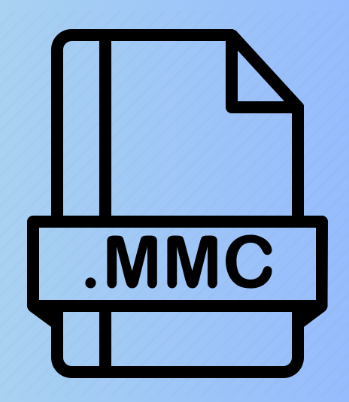.MMC File Extension

Microsoft Media Catalog
| Developer | Microsoft |
| Popularity | |
| Category | Data Files |
| Format | .MMC |
| Cross Platform | Update Soon |
What is an MMC file?
.MMC, which stands for Microsoft Management Console, is a file extension used for storing configuration settings and management tasks in Microsoft Windows operating systems.
These files are commonly used by system administrators to create custom consoles for managing various aspects of the operating system, including device management, user accounts, and security policies.
More Information.
.MMC files were introduced as part of the Windows 2000 operating system. The initial purpose of .MMC files was to streamline system administration by providing a centralized platform for creating custom management consoles.
System administrators could use .MMC files to combine various snap-ins, which are specialized management tools, into a single console, simplifying the management of a Windows system.
Origin Of This File.
The .MMC file extension is closely associated with Microsoft Windows and was introduced with Windows 2000. It was developed to provide a unified framework for system administrators to create, customize, and manage administrative tools and utilities.
.MMC files are used to define the layout and content of management consoles, making it easier to perform system administration tasks.
File Structure Technical Specification.
.MMC files are saved in a binary format and contain information about the console’s layout, menu items, toolbar options, and the various snap-ins included in the console.
These files have a .mmc file extension and can be opened using the Microsoft Management Console application, which is a built-in tool in Windows.
How to Convert the File?
Windows:
Converting .MMC files on a Windows system typically involves exporting or saving the configuration in a different format.
Below are a few steps you should follow in order to succeed:
- Open the .MMC File: Double-click on the .MMC file to open it in Microsoft Management Console.
- Export Configuration: Once the .MMC console is open, go to the “File” menu and select “Options.” In the “Console Options” window, you’ll find an option to “Save the console file” or “Save As.” Choose this option.
- Choose File Format: In the “Save As” dialog, you can choose from various file formats to save the configuration. Common formats include “.msc” (Microsoft Management Console) and “.xml” (Extensible Markup Language). Select the format that best suits your needs.
- Specify File Name and Location: Provide a name for the converted file and select the destination folder where you want to save it. Click “Save.”
The .MMC file is now converted to the selected format, making it accessible on Windows or other compatible platforms.
Linux:
Converting .MMC files on Linux can be challenging, as .MMC files are primarily designed for Windows. To access .MMC files on a Linux system, you may need to use virtualization or emulation software to run Windows within a Linux environment.
Here’s a brief outline of the process:
- Install Virtualization Software: Install a virtualization software tool such as VirtualBox or VMware Workstation on your Linux system.
- Create a Windows Virtual Machine: Using the virtualization software, create a virtual machine with a Windows operating system.
- Install Windows: Install Windows on the virtual machine as you would on a physical computer.
- Open the .MMC File: Once Windows is up and running in the virtual machine, you can open the .MMC file as you would on a native Windows system.
Mac:
Converting .MMC files on a Mac follows a similar process to that on a Linux system, as .MMC files are Windows-specific. Here’s how to do it:
- Install Virtualization Software: Install a virtualization software application like Parallels Desktop or VMware Fusion on your Mac.
- Create a Windows Virtual Machine: Use the virtualization software to create a virtual machine with a Windows operating system.
- Install Windows: Install Windows on the virtual machine as you would on a physical PC.
- Open the .MMC File: Once Windows is running within the virtual machine on your Mac, you can open the .MMC file as you would on a native Windows system.
Android:
- Install a Remote Desktop App: You’ll need to install a remote desktop application on your Android device. Apps like Microsoft Remote Desktop or TeamViewer are popular choices.
- Set Up a Windows Machine: Ensure you have access to a Windows machine that has the necessary software and .MMC files you want to access. This could be a physical Windows PC or a remote Windows server.
- Connect to the Windows Machine: Open the remote desktop app on your Android device and configure it to connect to the Windows machine where your .MMC files are stored.
- Access .MMC Files: Once the remote connection is established, you can navigate to the .MMC files on the Windows machine and open them as you would on a native Windows system.
iOS:
- Install a Remote Desktop App: On your iOS device, install a remote desktop application like Microsoft Remote Desktop or TeamViewer from the App Store.
- Set Up a Windows Machine: Ensure you have access to a Windows machine with the required software and .MMC files you want to access. This could be a physical Windows PC or a remote Windows server.
- Connect to the Windows Machine: Open the remote desktop app on your iOS device and configure it to connect to the Windows machine where your .MMC files are located.
- Access .MMC Files: Once the remote connection is established, you can navigate to the .MMC files on the Windows machine and open them as if you were using a native Windows system.
Advantages And Disadvantages.
Advantages:
- Customization: .MMC files allow system administrators to create customized management consoles tailored to their specific needs.
- Centralized Management: They provide a single point for managing various system administration tasks.
- Efficiency: .MMC files streamline administrative tasks, saving time and reducing complexity.
Disadvantages:
- Windows Dependency: .MMC files are primarily used in Windows environments and may not be compatible with other operating systems.
- Complexity: Creating and configuring .MMC files can be complex and may require a learning curve.
- Potential for Errors: Incorrectly configured .MMC files can lead to administrative errors.
How to Open MMC?
Open In Windows
- Direct Opening: .MMC files are native to Windows. To open an MMC file, simply double-click on it. This action will launch the Microsoft Management Console with the snap-ins configured in the file.
- Through .MMC Application: Alternatively, you can open the .MMC application first by searching for ‘.mmc’ in the Start Menu, and then use ‘File > Open’ to navigate to and open your .MMC file.
- Administrative Privileges: Some .MMC files may require administrative privileges. Right-click the file and select ‘Run as administrator’ if necessary.
Open In Linux
- Using Wine: Linux doesn’t natively support .MMC files. However, you can use Wine, a compatibility layer, to run Windows applications on Linux. Install Wine and then attempt to open the .MMC file with it. Success can vary depending on the specific Linux distribution and the content of the .MMC file.
- Virtual Machine: Another option is to run a Windows virtual machine on your Linux system using tools like VirtualBox or VMware. Within this virtual environment, you can open .MMC files as you would in Windows.
Open In MAC
- Virtualization Software: On a Mac, you can use virtualization software such as Parallels Desktop or VMware Fusion to create a Windows environment. Within this virtual Windows, you can open and use .MMC files.
- Boot Camp: If you have a dual-boot setup with Boot Camp, you can switch to your Windows partition and open .MMC files there.
Open In Android
.MMC files are not designed for Android. You cannot open .MMC files on an Android device as they are tailored for Windows system administration.
Open In IOS
.MMC files are not designed for iOS. You cannot open .MMC files on an iOS device as they are specific to Windows administration.
Open in Others
.MMC files are primarily used in Windows environments, and compatibility with other operating systems is limited.
For other operating systems, you may need to explore virtualization or emulation options to work with .MMC files.










